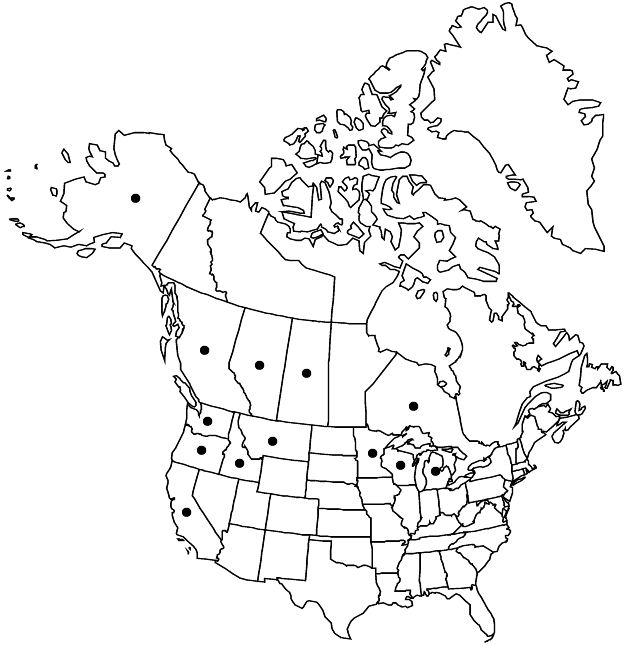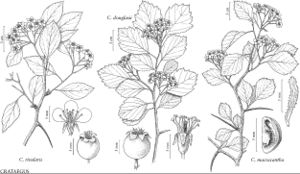Crataegus douglasii
Edwards's Bot. Reg. 21: plate 1810. 1835.
Shrubs, 40–80 dm. Stems: 1-year old twigs deep tan to dark mahogany, ± shiny young, older gray to dark gray, often showing brown or alternatively tan-brown eastward; thorns on twigs straight or slightly recurved, deep brown young, (1.5–) 2–3.5 cm. Leaves: petiole 0.7–1.5 cm, pubescent young, slightly glandular; blade usually elliptic to broadly elliptic or subrhombic (elliptic-obovate when lobes very small), 4–7 cm, lobes 2–4 per side, sinuses shallow, LII 10–20%, lobe apex subobtuse to acute, margins coarsely, sharply serrate, teeth small, gland-tipped young, venation craspedodromous, veins 4 or 5 per side, apex acute to obtuse, abaxial surface usually glabrous except on veins, adaxial densely short-appressed-pubescent. Inflorescences 10–25-flowered; branches glabrous; bracteole margins stipitate or sessile-glandular. Flowers 10–15 mm diam.; hypanthium glabrous; sepals broadly triangular, 3–4 mm, margins sparsely glandular, adaxially glabrous; stamens 10, anthers pink; styles 3 or 4. Pomes vinous and usually waxy glaucous young, dull black mature, usually ellipsoid, 6–8 mm diam., glabrous; sepal remnants reflexed, apex obtuse; pyrenes 3 or 4, sides excavated, sometimes only shallowly. 2n = 68.
Phenology: Flowering May–Jun; fruiting Sep–Oct.
Habitat: Brush, old fields, fencerows, woodland edges
Elevation: 50–1600 m
Distribution

Alta., B.C., Ont., Sask., Alaska, Calif., Idaho, Mich., Minn., Mont., Oreg., Wash., Wis.
Discussion
Crataegus douglasii occurs from southern and western British Columbia to the panhandle of Alaska and ranges to northern California and the Rocky Mountains of Idaho, Montana, and southwestern Alberta. Disjunct populations occur farther east in the Cypress Hills (Alberta and Saskatchewan), the Montana montane islands, and around the northern Great Lakes. In western North America, C. douglasii is found mainly near water in drier areas; in more mesic regions, it may occur in open woodlands. In the Great Lakes area, it mainly occurs in old pastures and on fencerows.
Crataegus douglasii is distinguished from C. gaylussacia by having ten stamens and is rather variable in leaf shape and size. The species is distinguished from C. okennonii by the latter usually being taller and typically more erect as well as having a usually straight, single trunk, shorter thorns, ampulliform-orbicular fruit, and often purplish crimson fall foliage. Crataegus castlegarensis is the most similar species, and beyond possessing relatively few to many multiple thorns, it is distinguished from C. douglasii by its hairy hypanthia, pedicels, and, often, fruit, which is orbicular, plump, crimson to purple in late August, ripening to deep purple (sometimes black) at a time when sympatric C. douglasii is fully black.
Selected References
None.
Lower Taxa
"thin" is not a number."thick" is not a number."adnate" is not a number."dm" is not declared as a valid unit of measurement for this property.
